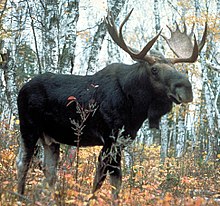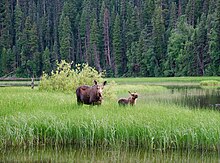Western moose
This articleneeds additional citations forverification.(November 2011) |
| Western moose | |
|---|---|

| |
| Scientific classification | |
| Domain: | Eukaryota |
| Kingdom: | Animalia |
| Phylum: | Chordata |
| Class: | Mammalia |
| Order: | Artiodactyla |
| Family: | Cervidae |
| Subfamily: | Capreolinae |
| Genus: | Alces |
| Species: | |
| Subspecies: | A. a. andersoni
|
| Trinomial name | |
| Alces alces andersoni Peterson, 1952[1]
| |
TheWestern moose[2](Alces alces andersoni) is a subspecies ofmoosethat inhabitsboreal forestsand mixeddeciduous forestsin theCanadian Arctic,western Canadian provincesand a few western sections of the northernUnited Statesand it was introduced toNew Zealand.It is the second largest North American subspecies of moose, second to theAlaskan moose.This subspecies is prey totimber wolvesandbears.Male Western moose are aggressive during mating season (autumn and winter) and may injure or kill with provocation.
Habitat, range, and distribution
[edit]The Western moose inhabitsBritish Columbia,easternYukon,Northwest Territories,southwesternNunavut,Alberta,Saskatchewan,Manitoba,westernOntario,the upper peninsula ofMichigan,northernWisconsin,northernMinnesota,and northeasternNorth Dakota. Additionally,Parks Canadatransferred eighteen western moose fromElk Island National ParktoNova Scotia'sCape Breton Highlands National Parkbetween 1947 and 1949 for population increase.Cape Breton Island's moose are descendants of these western moose.
[3][4]They were also introduced toNew Zealand'sFiordland National Park.[5]
Diet
[edit]Western moose eat terrestrial vegetation such asforbsandshootsfromwillowandbirchtrees and aquatic plants, includingliliesand pondweed. Western moose can consume up to 9,770 calories a day, about 32 kilograms (71 lb). The Western moose, like other species, lacks upper front teeth but instead has eight sharpincisorson its lower jaw. They also have a tough tongue, gums, and lips to help chew woody vegetation.
Size and weight
[edit]Male Western moose stand anywhere from 1.9 to 2.0 metres (6.2 to 6.6 ft) at the shoulder. Theirantlersspan 1.5 to 1.7 metres (4.9 to 5.6 ft) and they weigh anywhere from 380–720 kilograms (840–1,590 lb). Female Western moose stand at 1.8 metres (5 ft 11 in) on average, and weigh anywhere from 270 to 360 kilograms (600 to 790 lb).
Social structure and reproduction
[edit]
Western moose do not form social bonds and only come into contact to mate or to battle for a mate. Elevatedtestosteronelevels during mating season mean that bulls may attack anything during mating season, including humans,coyotes,wild boars,deer,red foxes,cougars,wolfpacks,Grizzly bears,elk,andblack bears.They use a subtlemating callto attract females or to announce to other males that they are in the area. In the event of a fight over mating rights, bull moose risk locking their antlers, which almost always results in them both dying from starvation. Western moose females will have, on average, one or twocalvesat once. A female may attack if she feels that her calves are threatened, although, at around 10–11 months yearling Western moose are chased off by their mothers to fend for themselves.
Hunting
[edit]With a population of about 950,000 individuals, they are hunted every autumn and winter in both Canada and the United States. Annual quotas vary depending on local population estimates and hunter success from the previous season.
References
[edit]- ^Albert W. Franzmann (1981-05-08)."Alces alces"(PDF).Mammalian Species(154): 1–7.doi:10.2307/3503876.JSTOR3503876.S2CID253963283.Archived fromthe original(PDF)on 2013-12-31.Retrieved2012-02-21.
- ^Canadian Wildlife Service(1950)."Mammals".Wildlife Management Bulletin.1(1–11): 7.
- ^Pulsifer, M. D.; Nette, T. L. (1995)."History, status and present distribution of moose in Nova Scotia".Alces: A Journal Devoted to the Biology and Management of Moose.31:209–219.
- ^"Mainland Moose Frequently Asked Questions | novascotia.ca".
- ^"ExploreNorth".
